To the OHA team:
One of the cornerstones of our work is protecting and promoting healthy Oregon communities. Over the past few months, we’ve been working with the Department of Environmental Quality (DEQ) and the Multnomah County Health Department (MCHD) to address air safety issues in the Portland area, especially around glass factories. This week, we took that work to a different level.
On Thursday, DEQ Interim Director Pete Shepherd and I launched a statewide regulatory reform process to create health-based air quality rules for all of Oregon—and fix major gaps in air safety rules that emissions from the glass companies have revealed. This overhaul is a key component of Governor Brown’s Cleaner Air Oregon program. It is an important step for Oregon and our agencies.
| |
 |
| |
Lynne Saxton speaks at the April 21 Environmental Quality Commission meeting |
Our goal is to connect Oregon’s air toxics regulations to the values Oregonians care about most: healthy people and families, clean air and water, and economically thriving communities. Because we are rethinking our environmental quality regulations to focus on health, it means OHA will participate in the process in a much more intensive way. We will go beyond the limited technical advisory role we’ve played in DEQ rule-making in the past. This time, we will partner with DEQ every step of the way in producing new regulations.
This regulatory overhaul will extend well into next year. Reforming Oregon’s air quality regulations is an urgent and necessary task. At the same time, it’s important we take the time to hear from all parts of Oregon’s diverse geographic and stakeholder communities so we get it right.
Taking action to protect health during regulatory reform
In the meantime, OHA will continue to work with our state and local partners to help communities identify, assess and address environmental health issues confronting their residents.
On Thursday we announced our plan to launch Healthy Places Oregon. Depending on funding, our goal is to collaborate with five to 10 priority communities across Oregon to evaluate the environmental factors that affect the health of individuals, families and their surrounding neighborhoods.
Different communities face different challenges. In some places, residents may have concerns about industrial emissions. In others, it might be air pollution from cars and trucks. In others, it could be wood smoke, pesticides, or the health impacts of climate change. In each community, we want to work with neighbors and local leaders to conduct a public health assessment and identify solutions they can pursue.
In addition, we’ll continue to focus on helping residents of Portland neighborhoods exposed to emissions from glass manufacturing facilities. We’re analyzing weekly air sampling data to ensure people aren’t exposed to unhealthy levels of emissions. We’re conducting a comprehensive analysis of long-term health effects. We’re continuing to require that urine tests which show high levels of cadmium be reported to our Public Health Division and we’re providing no-cost tests to those who live near the glass factories. Most importantly, we are providing residents with up-to-date information about safer air so they can make informed decisions.
Together with our partners, we can make Oregon a state of healthy places and people. Thank you for all you do to improve the health of Oregonians.
Thank you,
Lynne
To your health: Happy Earth Day! We live in a state full of spectacular physical wonders, but some communities don’t share the same access to physical health. In Oregon, place matters. And when we make better places, we make better lives. Find out how you can join the conversation by visiting placemattersoregon.com. In the meantime, get outside and enjoy everything our beautiful environment has to offer. |